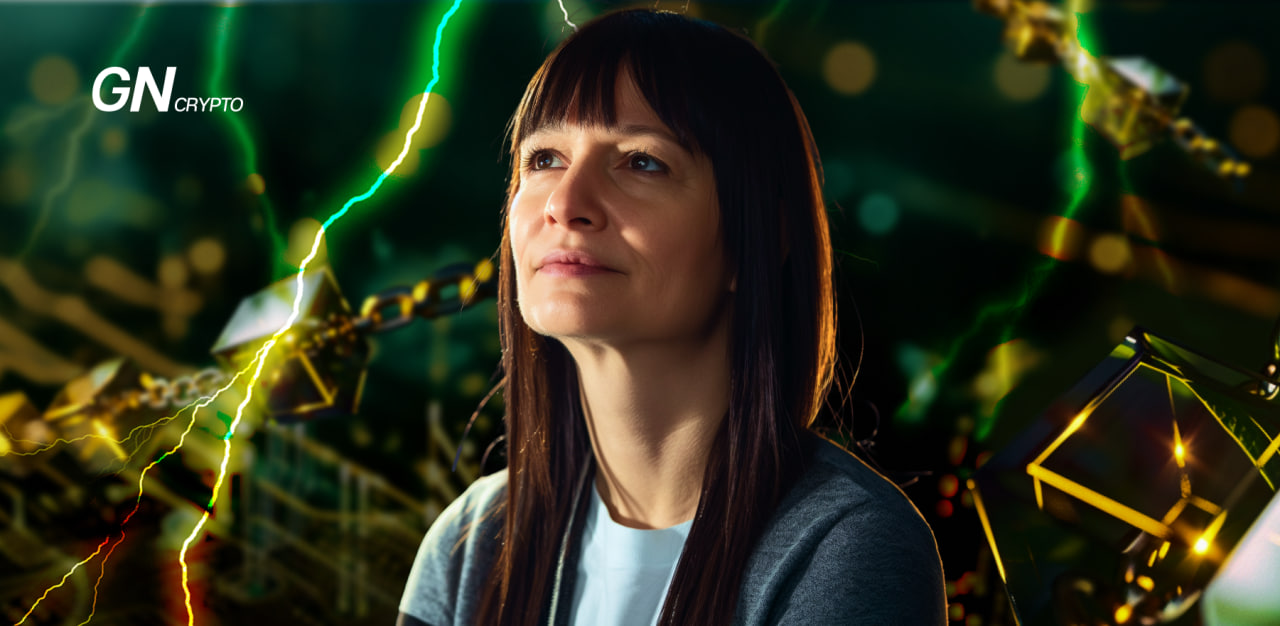Elizabeth Stark: Lightning Labs Co-Founder and CEO

Women founders in blockchain are rare. Elizabeth Stark, the co-founder, and CEO of Lightning Labs is one of the few who breaks the stereotype. Stark founded the company in 2016 to build blockchain scaling solutions. Read on to find out more about Elizabeth Stark and her role in crypto.
On this page
Elizabeth Stark’s Education, Career, and Path to Blockchain
The Lightning Labs CEO was born on March 29, 1981, in Brooklyn. She got interested in tech early on and interned at startups as a teenager. Stark studied International Business at Brown University and continued her education at Harvard University Law School. Here, she worked with Harvard Advocates to promote human rights.
During her final year at Harvard, Elizabeth founded the Harvard Free Culture Group. She also was an editor of the Harvard Journal of Law & Technology, where she researched the legal aspects of new technologies. Elizabeth was engaged in projects such as Filtering and the Digital Media Exchange for Harvard’s research center, The Berkman Klein Center for Internet & Society. She worked in different countries and speaks French, German, and Portuguese apart from English.
Being actively engaged in the academic community, Stark has been an advocate for open internet. She taught computer science and human rights courses at leading Universities, including Yale, Stanford, and Harvard.
For her role in the technology industry, Stark was named as one of the most influential women of 2010 by Fast Company. She was a leader in the global free culture movement, speaking for technological freedom. That means accessibility to open-source software, content, and the Web. As a part of this, Elizabeth was a co-founder of the Open Video Alliance, an organization focused on advocating for open standards and practices in online video.
Source: fastcompany.com
Founding of Lightning Labs
It was in 2010 when Elizabeth Stark first heard about Bitcoin from a teaching assistant at Stanford. The concept of open-source money got her interested, and she started studying the technology and soon became an active community member.
Talking about her discovery of Bitcoin at the Blockstack Summit 2017, Stark mentioned she instantly thought Bitcoin could be the key to free internet. She explained that when the World Wide Web appeared in 1995, everybody was able to run their own servers. But things changed with the emergence of centralized networks and the control of user data. According to her, Bitcoin could bring decentralization back:
When I first heard about Bitcoin in 2010, I saw this potential to re-decentralize the internet and to move things in a way back to the more mid-90s decentralization that we had,
Stark said.
Meanwhile, Stark noticed the scalability challenges of Bitcoin, particularly its ability to handle a large volume of transactions and meet increasing demand. The difficulty to scale results in slower transaction processing and higher fees at times of high demand. As Bitcoin's block size is limited to 1 MB, every second the network is capable of processing 7 transactions. On average, transactions take 10 minutes.
In 2015, Bitcoin community members Joseph Poon and Thaddeus Dryja published a white paper for the scalability solution, the Lightning Network. The concept was to build a second layer that operates on top of the Bitcoin Network, taking some of the transactions off-chain. Elizabeth Stark got familiar with the team and took part in the project from the start. To turn the concept of the Lightning Network into reality, she and Thaddeus Dryja co-founded Lightning Labs. (Dryja moved to other projects later).
The development of the Lightning Network took several years. It was officially launched on Bitcoin in March 2018. Lightning saw high support by investors, and raised $82.5 M in total since the start of its foundation. Among the investors were Jack Dorsey, Square Capital, Valor Equity Partners, NYDIG, and others.
Stark has been the CEO of Lightning Labs from its foundation to today. According to colleagues, her leadership approach played a decisive role in the company’s success. Stark is credited with making connections with investors like former PayPal COO David Sacks, and Square co-founder Jack Dorsey, among others. Leading the company, the Lightning CEO is driven by the mission to create a technology that lasts. Thaddeus Dryja, speaking to Coindesk, mentioned that Stark believed many great ideas might not succeed because having an idea and making it accessible to millions of people are different things.
In 2024, Lightning Network is the most popular Bitcoin scaling solution. It can handle up to 1 Million transactions per second at near-zero fees. Companies integrate Lightning to offer customers fast, cheap, and instant or near-instant Bitcoin payments.
From the Technological Freedom Movement to the Bitcoin Scaling Movement
Taking a look at Elizabeth Stark’s path, views, and skills, it becomes clear that she’s a leader of the most popular Bitcoin scaling solution not by chance. Open source technology, open finance, open internet, and equity are ideas that Stark has always stood for. In 2024, Stark continues to actively lead Lightning Labs. She has been on the list of Barron’s 100 Most Influential Women in U.S. Finance several times and is widely considered one of the most important people in crypto.
The content on The Coinomist is for informational purposes only and should not be interpreted as financial advice. While we strive to provide accurate and up-to-date information, we do not guarantee the accuracy, completeness, or reliability of any content. Neither we accept liability for any errors or omissions in the information provided or for any financial losses incurred as a result of relying on this information. Actions based on this content are at your own risk. Always do your own research and consult a professional. See our Terms, Privacy Policy, and Disclaimers for more details.


























